Toyota's Management and Operations: Analysis and Recommendations
VerifiedAdded on 2020/10/05
|18
|5420
|328
Report
AI Summary
This report provides a detailed analysis of Toyota's management and operations, beginning with an introduction to the company's history and its management structure. The report differentiates between the roles of managers and leaders, supported by relevant theories such as system theory, classical management theory, and contingency theory. It examines the strengths and weaknesses of both leadership and management approaches within Toyota, and analyzes the impact of managers and leaders on the organization. The report further explores Toyota's key operational functions, key operational approaches, and external factors affecting the business. It concludes with recommendations for improving operational efficiencies to meet business objectives. This report is a comprehensive overview of Toyota's operational and management strategies.
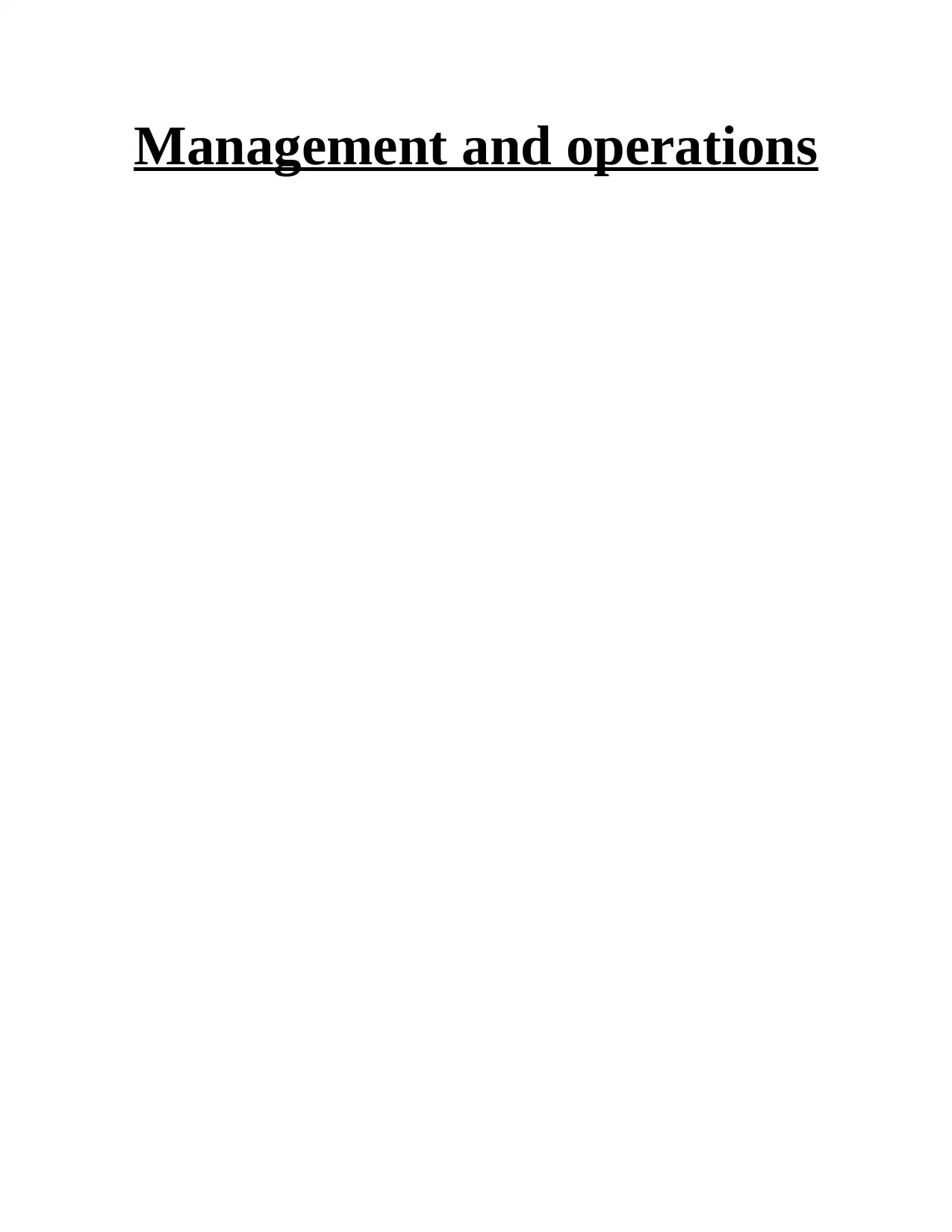
Management and operations
Paraphrase This Document
Need a fresh take? Get an instant paraphrase of this document with our AI Paraphraser
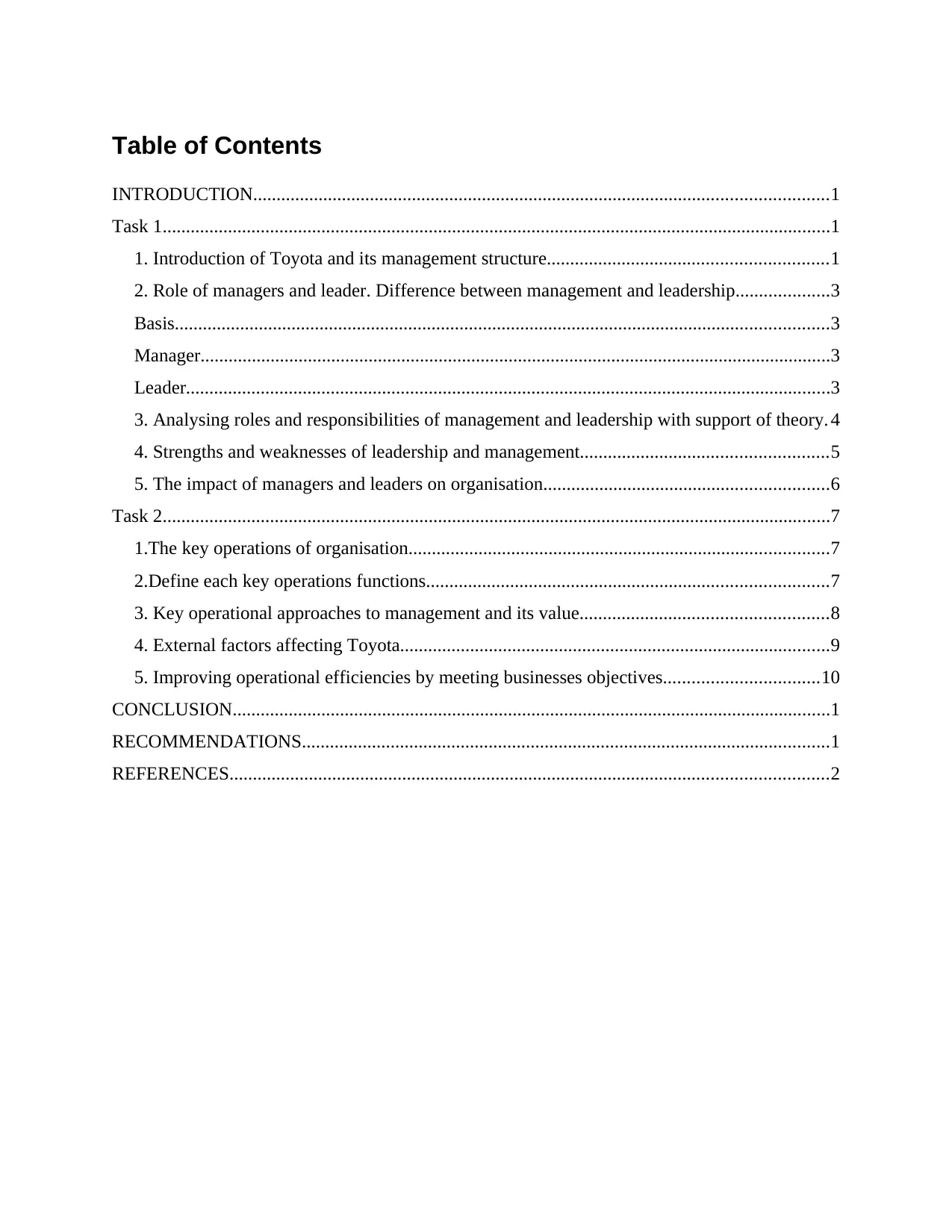
Table of Contents
INTRODUCTION...........................................................................................................................1
Task 1...............................................................................................................................................1
1. Introduction of Toyota and its management structure............................................................1
2. Role of managers and leader. Difference between management and leadership....................3
Basis............................................................................................................................................3
Manager.......................................................................................................................................3
Leader..........................................................................................................................................3
3. Analysing roles and responsibilities of management and leadership with support of theory. 4
4. Strengths and weaknesses of leadership and management.....................................................5
5. The impact of managers and leaders on organisation.............................................................6
Task 2...............................................................................................................................................7
1.The key operations of organisation..........................................................................................7
2.Define each key operations functions......................................................................................7
3. Key operational approaches to management and its value.....................................................8
4. External factors affecting Toyota............................................................................................9
5. Improving operational efficiencies by meeting businesses objectives.................................10
CONCLUSION................................................................................................................................1
RECOMMENDATIONS.................................................................................................................1
REFERENCES................................................................................................................................2
INTRODUCTION...........................................................................................................................1
Task 1...............................................................................................................................................1
1. Introduction of Toyota and its management structure............................................................1
2. Role of managers and leader. Difference between management and leadership....................3
Basis............................................................................................................................................3
Manager.......................................................................................................................................3
Leader..........................................................................................................................................3
3. Analysing roles and responsibilities of management and leadership with support of theory. 4
4. Strengths and weaknesses of leadership and management.....................................................5
5. The impact of managers and leaders on organisation.............................................................6
Task 2...............................................................................................................................................7
1.The key operations of organisation..........................................................................................7
2.Define each key operations functions......................................................................................7
3. Key operational approaches to management and its value.....................................................8
4. External factors affecting Toyota............................................................................................9
5. Improving operational efficiencies by meeting businesses objectives.................................10
CONCLUSION................................................................................................................................1
RECOMMENDATIONS.................................................................................................................1
REFERENCES................................................................................................................................2
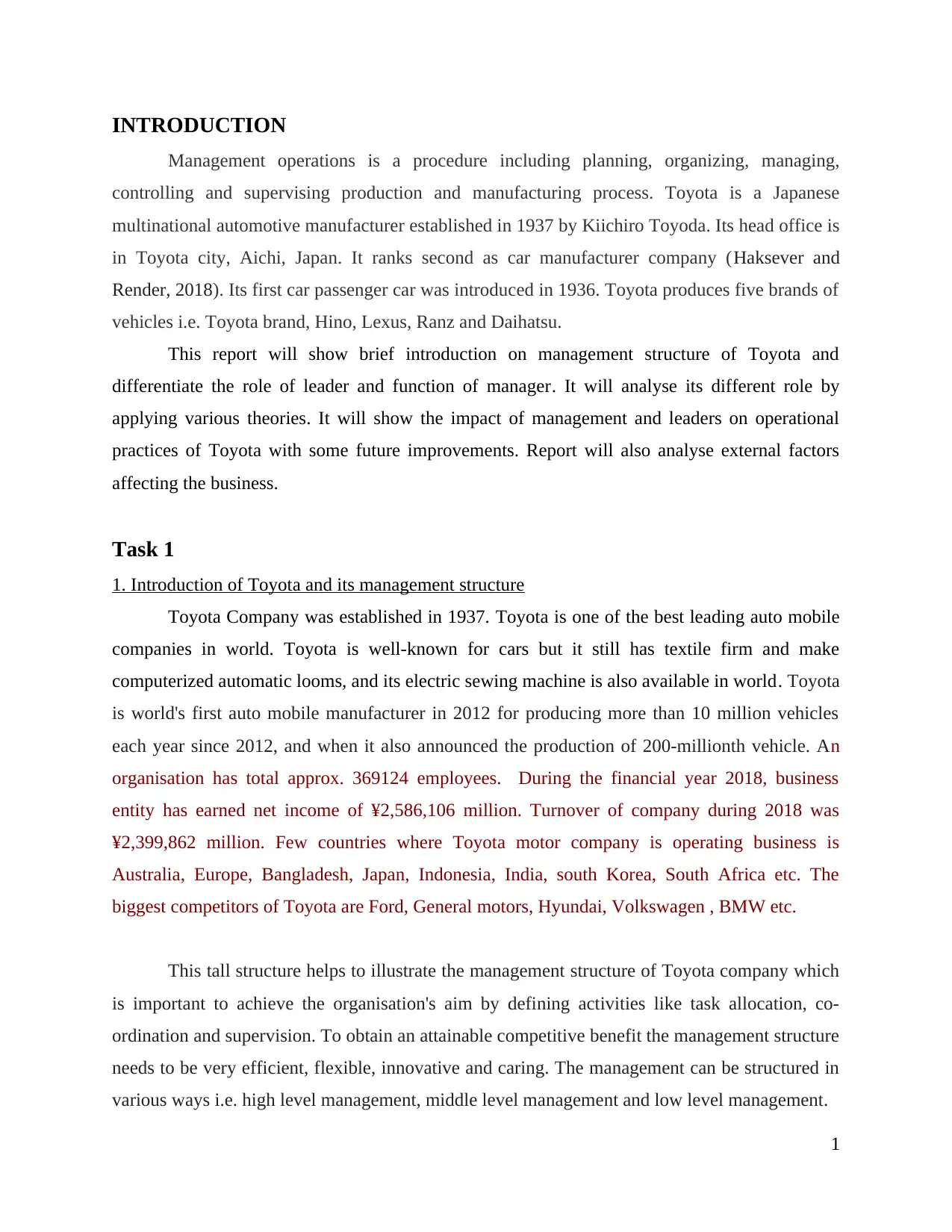
INTRODUCTION
Management operations is a procedure including planning, organizing, managing,
controlling and supervising production and manufacturing process. Toyota is a Japanese
multinational automotive manufacturer established in 1937 by Kiichiro Toyoda. Its head office is
in Toyota city, Aichi, Japan. It ranks second as car manufacturer company (Haksever and
Render, 2018). Its first car passenger car was introduced in 1936. Toyota produces five brands of
vehicles i.e. Toyota brand, Hino, Lexus, Ranz and Daihatsu.
This report will show brief introduction on management structure of Toyota and
differentiate the role of leader and function of manager. It will analyse its different role by
applying various theories. It will show the impact of management and leaders on operational
practices of Toyota with some future improvements. Report will also analyse external factors
affecting the business.
Task 1
1. Introduction of Toyota and its management structure
Toyota Company was established in 1937. Toyota is one of the best leading auto mobile
companies in world. Toyota is well-known for cars but it still has textile firm and make
computerized automatic looms, and its electric sewing machine is also available in world. Toyota
is world's first auto mobile manufacturer in 2012 for producing more than 10 million vehicles
each year since 2012, and when it also announced the production of 200-millionth vehicle. An
organisation has total approx. 369124 employees. During the financial year 2018, business
entity has earned net income of ¥2,586,106 million. Turnover of company during 2018 was
¥2,399,862 million. Few countries where Toyota motor company is operating business is
Australia, Europe, Bangladesh, Japan, Indonesia, India, south Korea, South Africa etc. The
biggest competitors of Toyota are Ford, General motors, Hyundai, Volkswagen , BMW etc.
This tall structure helps to illustrate the management structure of Toyota company which
is important to achieve the organisation's aim by defining activities like task allocation, co-
ordination and supervision. To obtain an attainable competitive benefit the management structure
needs to be very efficient, flexible, innovative and caring. The management can be structured in
various ways i.e. high level management, middle level management and low level management.
1
Management operations is a procedure including planning, organizing, managing,
controlling and supervising production and manufacturing process. Toyota is a Japanese
multinational automotive manufacturer established in 1937 by Kiichiro Toyoda. Its head office is
in Toyota city, Aichi, Japan. It ranks second as car manufacturer company (Haksever and
Render, 2018). Its first car passenger car was introduced in 1936. Toyota produces five brands of
vehicles i.e. Toyota brand, Hino, Lexus, Ranz and Daihatsu.
This report will show brief introduction on management structure of Toyota and
differentiate the role of leader and function of manager. It will analyse its different role by
applying various theories. It will show the impact of management and leaders on operational
practices of Toyota with some future improvements. Report will also analyse external factors
affecting the business.
Task 1
1. Introduction of Toyota and its management structure
Toyota Company was established in 1937. Toyota is one of the best leading auto mobile
companies in world. Toyota is well-known for cars but it still has textile firm and make
computerized automatic looms, and its electric sewing machine is also available in world. Toyota
is world's first auto mobile manufacturer in 2012 for producing more than 10 million vehicles
each year since 2012, and when it also announced the production of 200-millionth vehicle. An
organisation has total approx. 369124 employees. During the financial year 2018, business
entity has earned net income of ¥2,586,106 million. Turnover of company during 2018 was
¥2,399,862 million. Few countries where Toyota motor company is operating business is
Australia, Europe, Bangladesh, Japan, Indonesia, India, south Korea, South Africa etc. The
biggest competitors of Toyota are Ford, General motors, Hyundai, Volkswagen , BMW etc.
This tall structure helps to illustrate the management structure of Toyota company which
is important to achieve the organisation's aim by defining activities like task allocation, co-
ordination and supervision. To obtain an attainable competitive benefit the management structure
needs to be very efficient, flexible, innovative and caring. The management can be structured in
various ways i.e. high level management, middle level management and low level management.
1
⊘ This is a preview!⊘
Do you want full access?
Subscribe today to unlock all pages.

Trusted by 1+ million students worldwide
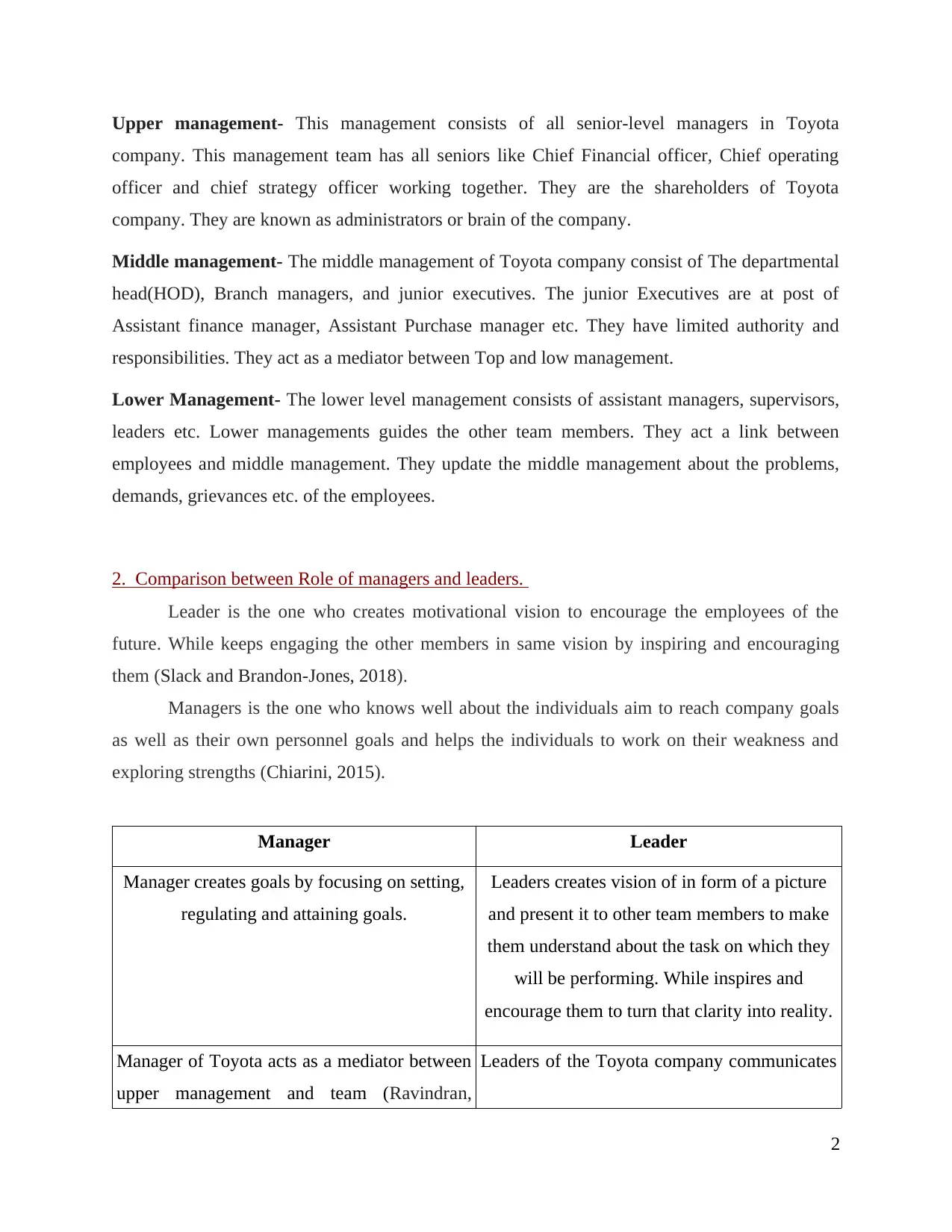
Upper management- This management consists of all senior-level managers in Toyota
company. This management team has all seniors like Chief Financial officer, Chief operating
officer and chief strategy officer working together. They are the shareholders of Toyota
company. They are known as administrators or brain of the company.
Middle management- The middle management of Toyota company consist of The departmental
head(HOD), Branch managers, and junior executives. The junior Executives are at post of
Assistant finance manager, Assistant Purchase manager etc. They have limited authority and
responsibilities. They act as a mediator between Top and low management.
Lower Management- The lower level management consists of assistant managers, supervisors,
leaders etc. Lower managements guides the other team members. They act a link between
employees and middle management. They update the middle management about the problems,
demands, grievances etc. of the employees.
2. Comparison between Role of managers and leaders.
Leader is the one who creates motivational vision to encourage the employees of the
future. While keeps engaging the other members in same vision by inspiring and encouraging
them (Slack and Brandon-Jones, 2018).
Managers is the one who knows well about the individuals aim to reach company goals
as well as their own personnel goals and helps the individuals to work on their weakness and
exploring strengths (Chiarini, 2015).
Manager Leader
Manager creates goals by focusing on setting,
regulating and attaining goals.
Leaders creates vision of in form of a picture
and present it to other team members to make
them understand about the task on which they
will be performing. While inspires and
encourage them to turn that clarity into reality.
Manager of Toyota acts as a mediator between
upper management and team (Ravindran,
Leaders of the Toyota company communicates
2
company. This management team has all seniors like Chief Financial officer, Chief operating
officer and chief strategy officer working together. They are the shareholders of Toyota
company. They are known as administrators or brain of the company.
Middle management- The middle management of Toyota company consist of The departmental
head(HOD), Branch managers, and junior executives. The junior Executives are at post of
Assistant finance manager, Assistant Purchase manager etc. They have limited authority and
responsibilities. They act as a mediator between Top and low management.
Lower Management- The lower level management consists of assistant managers, supervisors,
leaders etc. Lower managements guides the other team members. They act a link between
employees and middle management. They update the middle management about the problems,
demands, grievances etc. of the employees.
2. Comparison between Role of managers and leaders.
Leader is the one who creates motivational vision to encourage the employees of the
future. While keeps engaging the other members in same vision by inspiring and encouraging
them (Slack and Brandon-Jones, 2018).
Managers is the one who knows well about the individuals aim to reach company goals
as well as their own personnel goals and helps the individuals to work on their weakness and
exploring strengths (Chiarini, 2015).
Manager Leader
Manager creates goals by focusing on setting,
regulating and attaining goals.
Leaders creates vision of in form of a picture
and present it to other team members to make
them understand about the task on which they
will be performing. While inspires and
encourage them to turn that clarity into reality.
Manager of Toyota acts as a mediator between
upper management and team (Ravindran,
Leaders of the Toyota company communicates
2
Paraphrase This Document
Need a fresh take? Get an instant paraphrase of this document with our AI Paraphraser
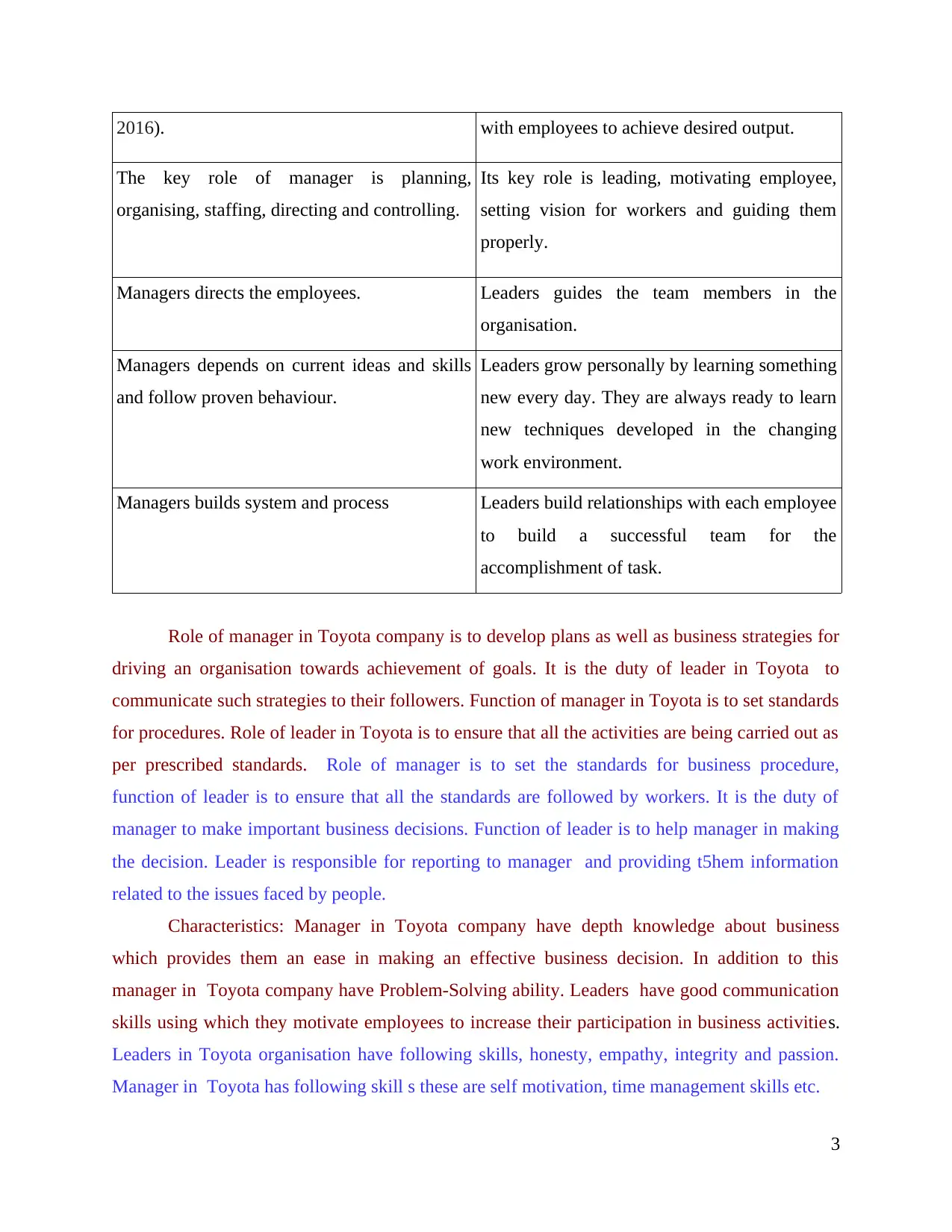
2016). with employees to achieve desired output.
The key role of manager is planning,
organising, staffing, directing and controlling.
Its key role is leading, motivating employee,
setting vision for workers and guiding them
properly.
Managers directs the employees. Leaders guides the team members in the
organisation.
Managers depends on current ideas and skills
and follow proven behaviour.
Leaders grow personally by learning something
new every day. They are always ready to learn
new techniques developed in the changing
work environment.
Managers builds system and process Leaders build relationships with each employee
to build a successful team for the
accomplishment of task.
Role of manager in Toyota company is to develop plans as well as business strategies for
driving an organisation towards achievement of goals. It is the duty of leader in Toyota to
communicate such strategies to their followers. Function of manager in Toyota is to set standards
for procedures. Role of leader in Toyota is to ensure that all the activities are being carried out as
per prescribed standards. Role of manager is to set the standards for business procedure,
function of leader is to ensure that all the standards are followed by workers. It is the duty of
manager to make important business decisions. Function of leader is to help manager in making
the decision. Leader is responsible for reporting to manager and providing t5hem information
related to the issues faced by people.
Characteristics: Manager in Toyota company have depth knowledge about business
which provides them an ease in making an effective business decision. In addition to this
manager in Toyota company have Problem-Solving ability. Leaders have good communication
skills using which they motivate employees to increase their participation in business activities.
Leaders in Toyota organisation have following skills, honesty, empathy, integrity and passion.
Manager in Toyota has following skill s these are self motivation, time management skills etc.
3
The key role of manager is planning,
organising, staffing, directing and controlling.
Its key role is leading, motivating employee,
setting vision for workers and guiding them
properly.
Managers directs the employees. Leaders guides the team members in the
organisation.
Managers depends on current ideas and skills
and follow proven behaviour.
Leaders grow personally by learning something
new every day. They are always ready to learn
new techniques developed in the changing
work environment.
Managers builds system and process Leaders build relationships with each employee
to build a successful team for the
accomplishment of task.
Role of manager in Toyota company is to develop plans as well as business strategies for
driving an organisation towards achievement of goals. It is the duty of leader in Toyota to
communicate such strategies to their followers. Function of manager in Toyota is to set standards
for procedures. Role of leader in Toyota is to ensure that all the activities are being carried out as
per prescribed standards. Role of manager is to set the standards for business procedure,
function of leader is to ensure that all the standards are followed by workers. It is the duty of
manager to make important business decisions. Function of leader is to help manager in making
the decision. Leader is responsible for reporting to manager and providing t5hem information
related to the issues faced by people.
Characteristics: Manager in Toyota company have depth knowledge about business
which provides them an ease in making an effective business decision. In addition to this
manager in Toyota company have Problem-Solving ability. Leaders have good communication
skills using which they motivate employees to increase their participation in business activities.
Leaders in Toyota organisation have following skills, honesty, empathy, integrity and passion.
Manager in Toyota has following skill s these are self motivation, time management skills etc.
3
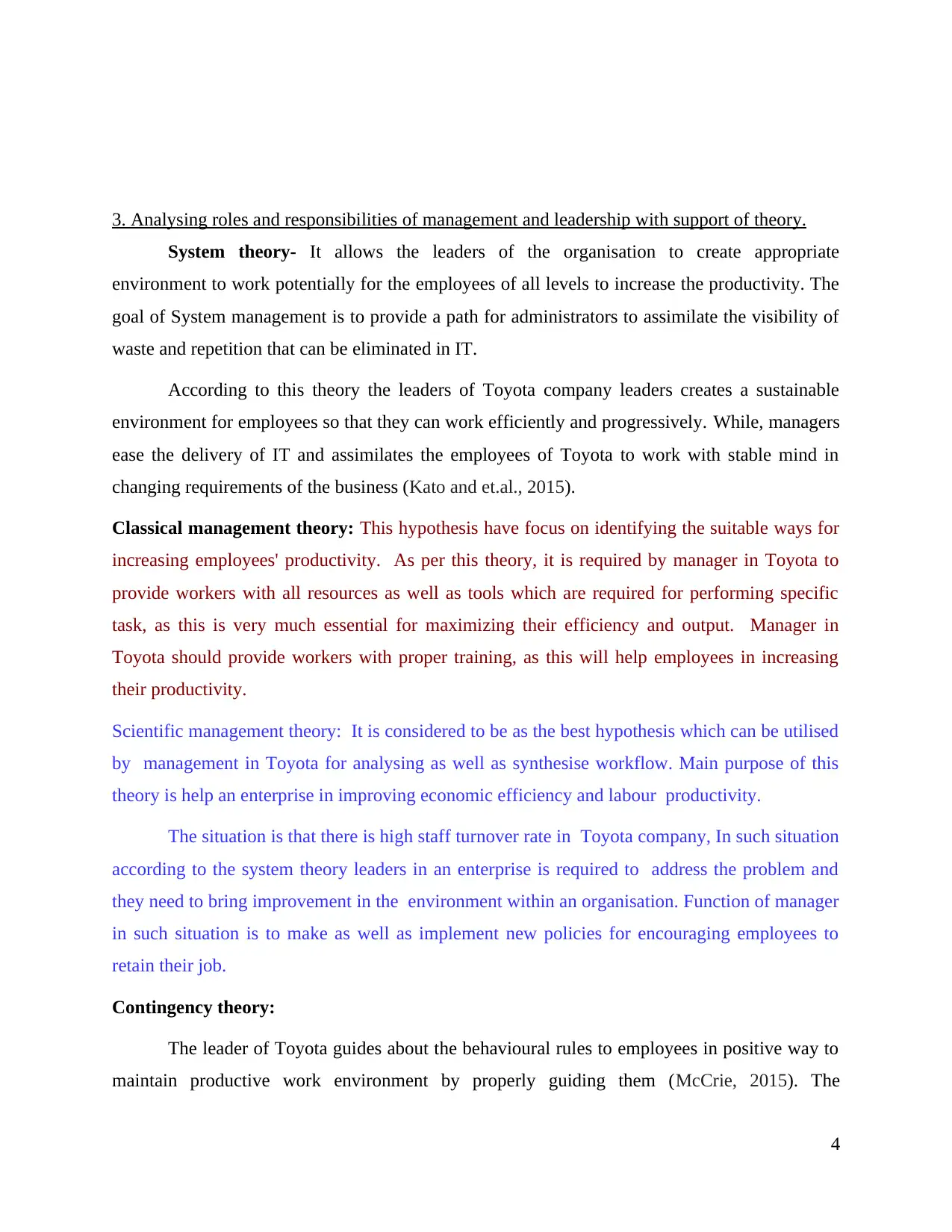
3. Analysing roles and responsibilities of management and leadership with support of theory.
System theory- It allows the leaders of the organisation to create appropriate
environment to work potentially for the employees of all levels to increase the productivity. The
goal of System management is to provide a path for administrators to assimilate the visibility of
waste and repetition that can be eliminated in IT.
According to this theory the leaders of Toyota company leaders creates a sustainable
environment for employees so that they can work efficiently and progressively. While, managers
ease the delivery of IT and assimilates the employees of Toyota to work with stable mind in
changing requirements of the business (Kato and et.al., 2015).
Classical management theory: This hypothesis have focus on identifying the suitable ways for
increasing employees' productivity. As per this theory, it is required by manager in Toyota to
provide workers with all resources as well as tools which are required for performing specific
task, as this is very much essential for maximizing their efficiency and output. Manager in
Toyota should provide workers with proper training, as this will help employees in increasing
their productivity.
Scientific management theory: It is considered to be as the best hypothesis which can be utilised
by management in Toyota for analysing as well as synthesise workflow. Main purpose of this
theory is help an enterprise in improving economic efficiency and labour productivity.
The situation is that there is high staff turnover rate in Toyota company, In such situation
according to the system theory leaders in an enterprise is required to address the problem and
they need to bring improvement in the environment within an organisation. Function of manager
in such situation is to make as well as implement new policies for encouraging employees to
retain their job.
Contingency theory:
The leader of Toyota guides about the behavioural rules to employees in positive way to
maintain productive work environment by properly guiding them (McCrie, 2015). The
4
System theory- It allows the leaders of the organisation to create appropriate
environment to work potentially for the employees of all levels to increase the productivity. The
goal of System management is to provide a path for administrators to assimilate the visibility of
waste and repetition that can be eliminated in IT.
According to this theory the leaders of Toyota company leaders creates a sustainable
environment for employees so that they can work efficiently and progressively. While, managers
ease the delivery of IT and assimilates the employees of Toyota to work with stable mind in
changing requirements of the business (Kato and et.al., 2015).
Classical management theory: This hypothesis have focus on identifying the suitable ways for
increasing employees' productivity. As per this theory, it is required by manager in Toyota to
provide workers with all resources as well as tools which are required for performing specific
task, as this is very much essential for maximizing their efficiency and output. Manager in
Toyota should provide workers with proper training, as this will help employees in increasing
their productivity.
Scientific management theory: It is considered to be as the best hypothesis which can be utilised
by management in Toyota for analysing as well as synthesise workflow. Main purpose of this
theory is help an enterprise in improving economic efficiency and labour productivity.
The situation is that there is high staff turnover rate in Toyota company, In such situation
according to the system theory leaders in an enterprise is required to address the problem and
they need to bring improvement in the environment within an organisation. Function of manager
in such situation is to make as well as implement new policies for encouraging employees to
retain their job.
Contingency theory:
The leader of Toyota guides about the behavioural rules to employees in positive way to
maintain productive work environment by properly guiding them (McCrie, 2015). The
4
⊘ This is a preview!⊘
Do you want full access?
Subscribe today to unlock all pages.

Trusted by 1+ million students worldwide
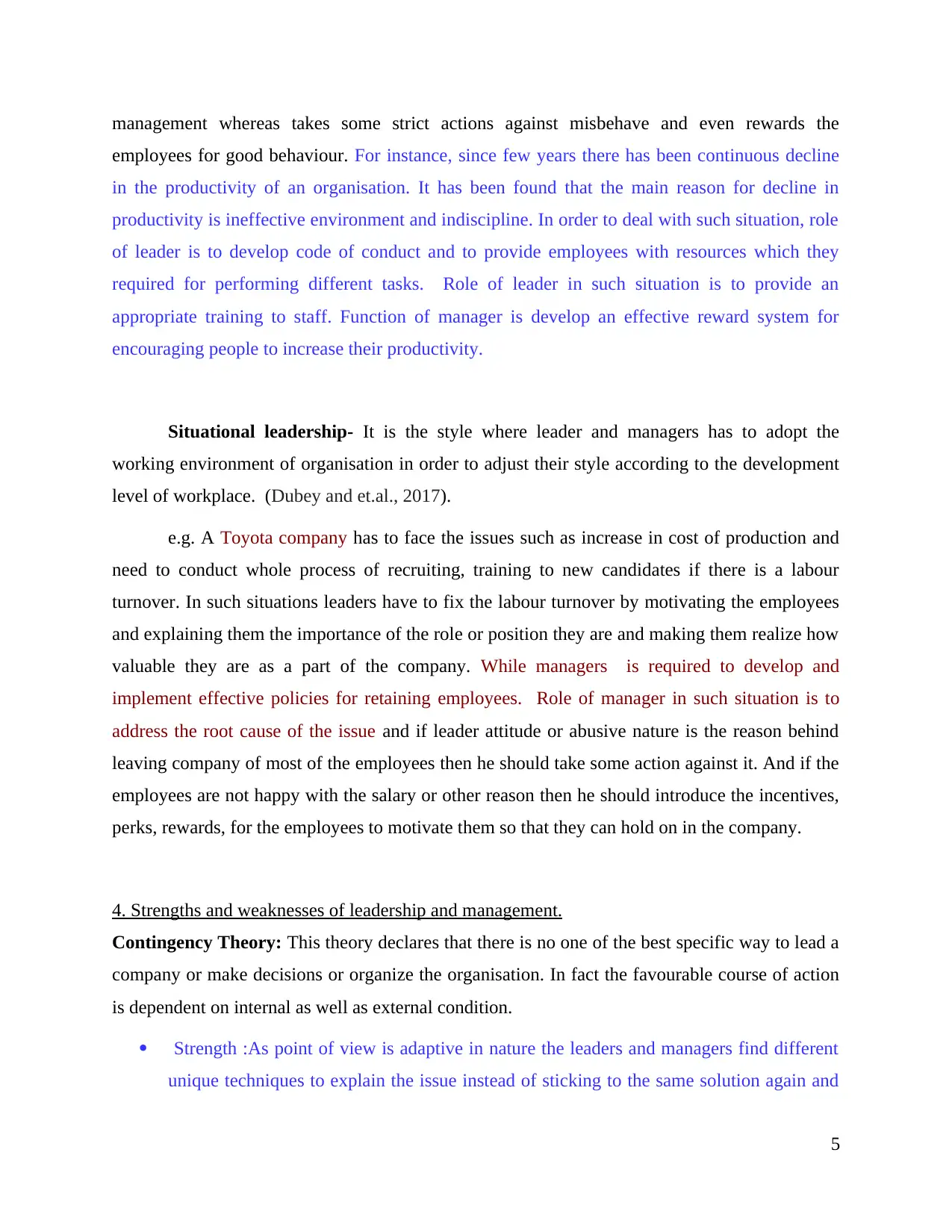
management whereas takes some strict actions against misbehave and even rewards the
employees for good behaviour. For instance, since few years there has been continuous decline
in the productivity of an organisation. It has been found that the main reason for decline in
productivity is ineffective environment and indiscipline. In order to deal with such situation, role
of leader is to develop code of conduct and to provide employees with resources which they
required for performing different tasks. Role of leader in such situation is to provide an
appropriate training to staff. Function of manager is develop an effective reward system for
encouraging people to increase their productivity.
Situational leadership- It is the style where leader and managers has to adopt the
working environment of organisation in order to adjust their style according to the development
level of workplace. (Dubey and et.al., 2017).
e.g. A Toyota company has to face the issues such as increase in cost of production and
need to conduct whole process of recruiting, training to new candidates if there is a labour
turnover. In such situations leaders have to fix the labour turnover by motivating the employees
and explaining them the importance of the role or position they are and making them realize how
valuable they are as a part of the company. While managers is required to develop and
implement effective policies for retaining employees. Role of manager in such situation is to
address the root cause of the issue and if leader attitude or abusive nature is the reason behind
leaving company of most of the employees then he should take some action against it. And if the
employees are not happy with the salary or other reason then he should introduce the incentives,
perks, rewards, for the employees to motivate them so that they can hold on in the company.
4. Strengths and weaknesses of leadership and management.
Contingency Theory: This theory declares that there is no one of the best specific way to lead a
company or make decisions or organize the organisation. In fact the favourable course of action
is dependent on internal as well as external condition.
Strength :As point of view is adaptive in nature the leaders and managers find different
unique techniques to explain the issue instead of sticking to the same solution again and
5
employees for good behaviour. For instance, since few years there has been continuous decline
in the productivity of an organisation. It has been found that the main reason for decline in
productivity is ineffective environment and indiscipline. In order to deal with such situation, role
of leader is to develop code of conduct and to provide employees with resources which they
required for performing different tasks. Role of leader in such situation is to provide an
appropriate training to staff. Function of manager is develop an effective reward system for
encouraging people to increase their productivity.
Situational leadership- It is the style where leader and managers has to adopt the
working environment of organisation in order to adjust their style according to the development
level of workplace. (Dubey and et.al., 2017).
e.g. A Toyota company has to face the issues such as increase in cost of production and
need to conduct whole process of recruiting, training to new candidates if there is a labour
turnover. In such situations leaders have to fix the labour turnover by motivating the employees
and explaining them the importance of the role or position they are and making them realize how
valuable they are as a part of the company. While managers is required to develop and
implement effective policies for retaining employees. Role of manager in such situation is to
address the root cause of the issue and if leader attitude or abusive nature is the reason behind
leaving company of most of the employees then he should take some action against it. And if the
employees are not happy with the salary or other reason then he should introduce the incentives,
perks, rewards, for the employees to motivate them so that they can hold on in the company.
4. Strengths and weaknesses of leadership and management.
Contingency Theory: This theory declares that there is no one of the best specific way to lead a
company or make decisions or organize the organisation. In fact the favourable course of action
is dependent on internal as well as external condition.
Strength :As point of view is adaptive in nature the leaders and managers find different
unique techniques to explain the issue instead of sticking to the same solution again and
5
Paraphrase This Document
Need a fresh take? Get an instant paraphrase of this document with our AI Paraphraser
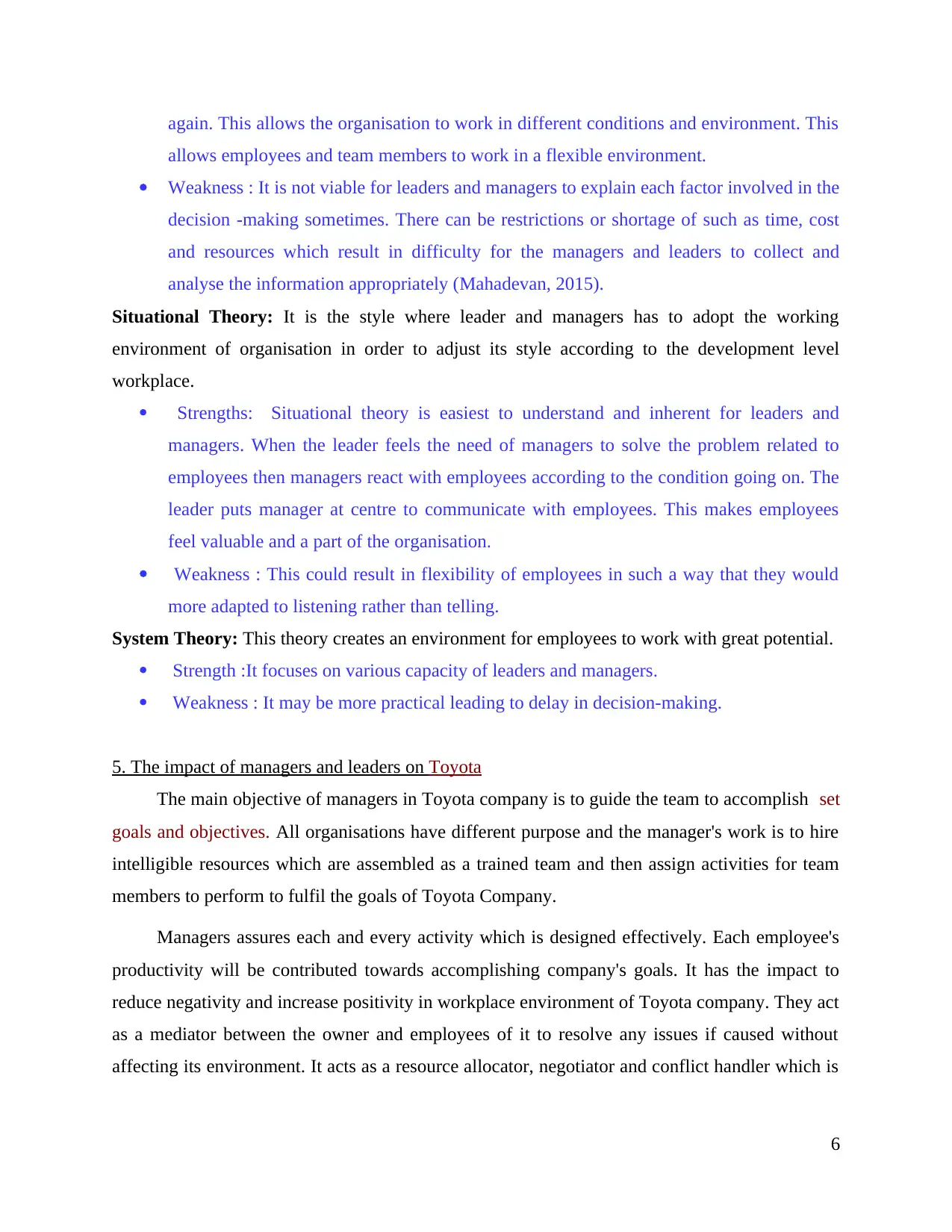
again. This allows the organisation to work in different conditions and environment. This
allows employees and team members to work in a flexible environment.
Weakness : It is not viable for leaders and managers to explain each factor involved in the
decision -making sometimes. There can be restrictions or shortage of such as time, cost
and resources which result in difficulty for the managers and leaders to collect and
analyse the information appropriately (Mahadevan, 2015).
Situational Theory: It is the style where leader and managers has to adopt the working
environment of organisation in order to adjust its style according to the development level
workplace.
Strengths: Situational theory is easiest to understand and inherent for leaders and
managers. When the leader feels the need of managers to solve the problem related to
employees then managers react with employees according to the condition going on. The
leader puts manager at centre to communicate with employees. This makes employees
feel valuable and a part of the organisation.
Weakness : This could result in flexibility of employees in such a way that they would
more adapted to listening rather than telling.
System Theory: This theory creates an environment for employees to work with great potential.
Strength :It focuses on various capacity of leaders and managers.
Weakness : It may be more practical leading to delay in decision-making.
5. The impact of managers and leaders on Toyota
The main objective of managers in Toyota company is to guide the team to accomplish set
goals and objectives. All organisations have different purpose and the manager's work is to hire
intelligible resources which are assembled as a trained team and then assign activities for team
members to perform to fulfil the goals of Toyota Company.
Managers assures each and every activity which is designed effectively. Each employee's
productivity will be contributed towards accomplishing company's goals. It has the impact to
reduce negativity and increase positivity in workplace environment of Toyota company. They act
as a mediator between the owner and employees of it to resolve any issues if caused without
affecting its environment. It acts as a resource allocator, negotiator and conflict handler which is
6
allows employees and team members to work in a flexible environment.
Weakness : It is not viable for leaders and managers to explain each factor involved in the
decision -making sometimes. There can be restrictions or shortage of such as time, cost
and resources which result in difficulty for the managers and leaders to collect and
analyse the information appropriately (Mahadevan, 2015).
Situational Theory: It is the style where leader and managers has to adopt the working
environment of organisation in order to adjust its style according to the development level
workplace.
Strengths: Situational theory is easiest to understand and inherent for leaders and
managers. When the leader feels the need of managers to solve the problem related to
employees then managers react with employees according to the condition going on. The
leader puts manager at centre to communicate with employees. This makes employees
feel valuable and a part of the organisation.
Weakness : This could result in flexibility of employees in such a way that they would
more adapted to listening rather than telling.
System Theory: This theory creates an environment for employees to work with great potential.
Strength :It focuses on various capacity of leaders and managers.
Weakness : It may be more practical leading to delay in decision-making.
5. The impact of managers and leaders on Toyota
The main objective of managers in Toyota company is to guide the team to accomplish set
goals and objectives. All organisations have different purpose and the manager's work is to hire
intelligible resources which are assembled as a trained team and then assign activities for team
members to perform to fulfil the goals of Toyota Company.
Managers assures each and every activity which is designed effectively. Each employee's
productivity will be contributed towards accomplishing company's goals. It has the impact to
reduce negativity and increase positivity in workplace environment of Toyota company. They act
as a mediator between the owner and employees of it to resolve any issues if caused without
affecting its environment. It acts as a resource allocator, negotiator and conflict handler which is
6
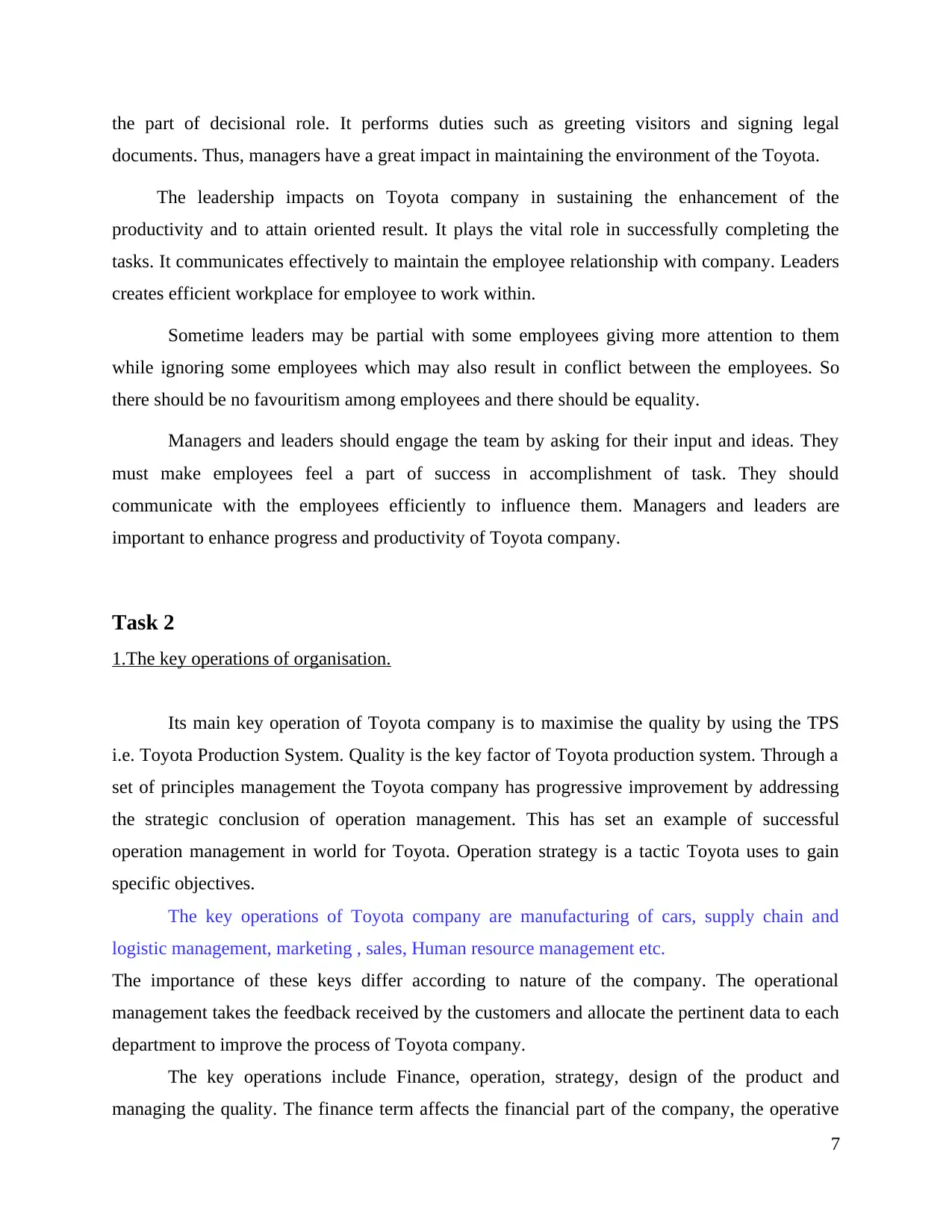
the part of decisional role. It performs duties such as greeting visitors and signing legal
documents. Thus, managers have a great impact in maintaining the environment of the Toyota.
The leadership impacts on Toyota company in sustaining the enhancement of the
productivity and to attain oriented result. It plays the vital role in successfully completing the
tasks. It communicates effectively to maintain the employee relationship with company. Leaders
creates efficient workplace for employee to work within.
Sometime leaders may be partial with some employees giving more attention to them
while ignoring some employees which may also result in conflict between the employees. So
there should be no favouritism among employees and there should be equality.
Managers and leaders should engage the team by asking for their input and ideas. They
must make employees feel a part of success in accomplishment of task. They should
communicate with the employees efficiently to influence them. Managers and leaders are
important to enhance progress and productivity of Toyota company.
Task 2
1.The key operations of organisation.
Its main key operation of Toyota company is to maximise the quality by using the TPS
i.e. Toyota Production System. Quality is the key factor of Toyota production system. Through a
set of principles management the Toyota company has progressive improvement by addressing
the strategic conclusion of operation management. This has set an example of successful
operation management in world for Toyota. Operation strategy is a tactic Toyota uses to gain
specific objectives.
The key operations of Toyota company are manufacturing of cars, supply chain and
logistic management, marketing , sales, Human resource management etc.
The importance of these keys differ according to nature of the company. The operational
management takes the feedback received by the customers and allocate the pertinent data to each
department to improve the process of Toyota company.
The key operations include Finance, operation, strategy, design of the product and
managing the quality. The finance term affects the financial part of the company, the operative
7
documents. Thus, managers have a great impact in maintaining the environment of the Toyota.
The leadership impacts on Toyota company in sustaining the enhancement of the
productivity and to attain oriented result. It plays the vital role in successfully completing the
tasks. It communicates effectively to maintain the employee relationship with company. Leaders
creates efficient workplace for employee to work within.
Sometime leaders may be partial with some employees giving more attention to them
while ignoring some employees which may also result in conflict between the employees. So
there should be no favouritism among employees and there should be equality.
Managers and leaders should engage the team by asking for their input and ideas. They
must make employees feel a part of success in accomplishment of task. They should
communicate with the employees efficiently to influence them. Managers and leaders are
important to enhance progress and productivity of Toyota company.
Task 2
1.The key operations of organisation.
Its main key operation of Toyota company is to maximise the quality by using the TPS
i.e. Toyota Production System. Quality is the key factor of Toyota production system. Through a
set of principles management the Toyota company has progressive improvement by addressing
the strategic conclusion of operation management. This has set an example of successful
operation management in world for Toyota. Operation strategy is a tactic Toyota uses to gain
specific objectives.
The key operations of Toyota company are manufacturing of cars, supply chain and
logistic management, marketing , sales, Human resource management etc.
The importance of these keys differ according to nature of the company. The operational
management takes the feedback received by the customers and allocate the pertinent data to each
department to improve the process of Toyota company.
The key operations include Finance, operation, strategy, design of the product and
managing the quality. The finance term affects the financial part of the company, the operative
7
⊘ This is a preview!⊘
Do you want full access?
Subscribe today to unlock all pages.

Trusted by 1+ million students worldwide
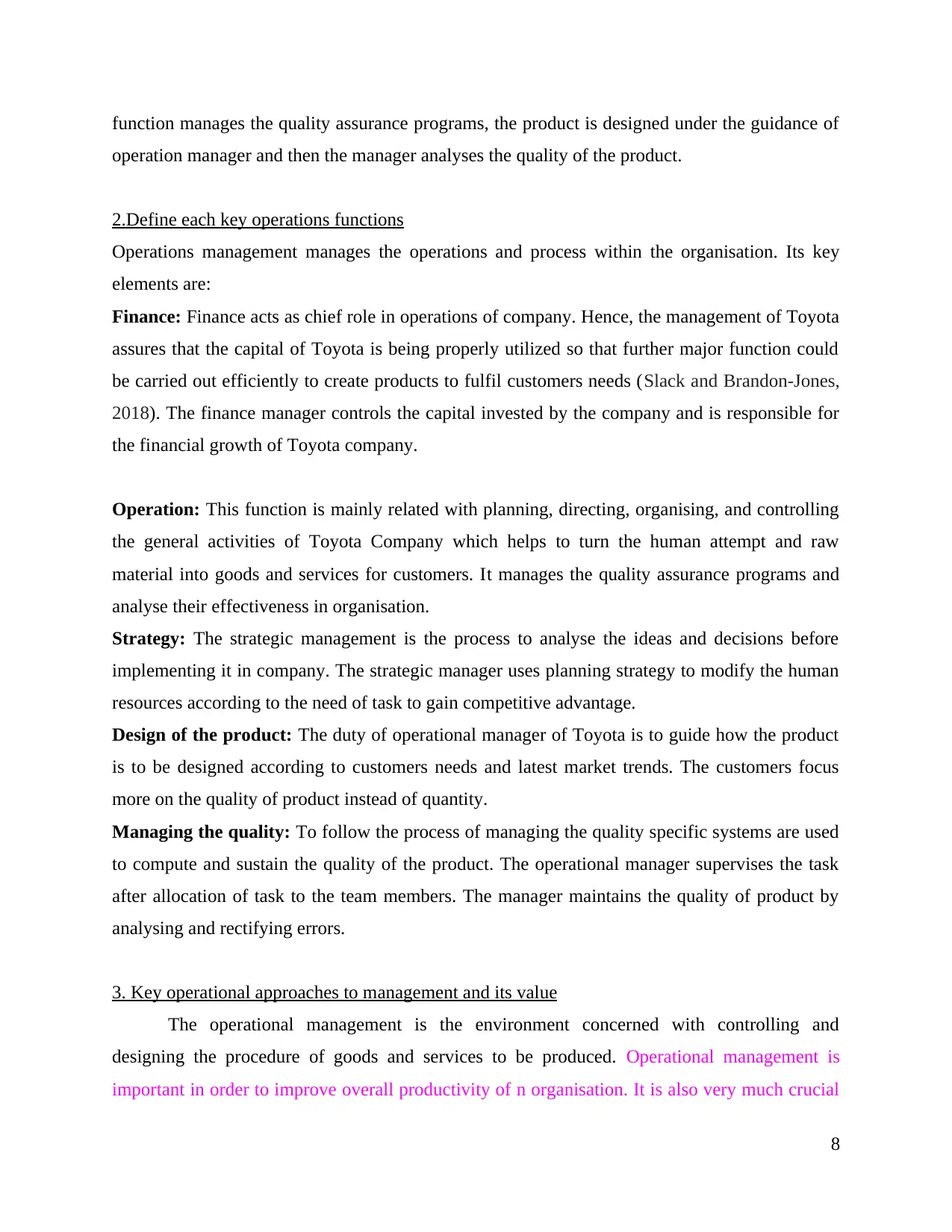
function manages the quality assurance programs, the product is designed under the guidance of
operation manager and then the manager analyses the quality of the product.
2.Define each key operations functions
Operations management manages the operations and process within the organisation. Its key
elements are:
Finance: Finance acts as chief role in operations of company. Hence, the management of Toyota
assures that the capital of Toyota is being properly utilized so that further major function could
be carried out efficiently to create products to fulfil customers needs (Slack and Brandon-Jones,
2018). The finance manager controls the capital invested by the company and is responsible for
the financial growth of Toyota company.
Operation: This function is mainly related with planning, directing, organising, and controlling
the general activities of Toyota Company which helps to turn the human attempt and raw
material into goods and services for customers. It manages the quality assurance programs and
analyse their effectiveness in organisation.
Strategy: The strategic management is the process to analyse the ideas and decisions before
implementing it in company. The strategic manager uses planning strategy to modify the human
resources according to the need of task to gain competitive advantage.
Design of the product: The duty of operational manager of Toyota is to guide how the product
is to be designed according to customers needs and latest market trends. The customers focus
more on the quality of product instead of quantity.
Managing the quality: To follow the process of managing the quality specific systems are used
to compute and sustain the quality of the product. The operational manager supervises the task
after allocation of task to the team members. The manager maintains the quality of product by
analysing and rectifying errors.
3. Key operational approaches to management and its value
The operational management is the environment concerned with controlling and
designing the procedure of goods and services to be produced. Operational management is
important in order to improve overall productivity of n organisation. It is also very much crucial
8
operation manager and then the manager analyses the quality of the product.
2.Define each key operations functions
Operations management manages the operations and process within the organisation. Its key
elements are:
Finance: Finance acts as chief role in operations of company. Hence, the management of Toyota
assures that the capital of Toyota is being properly utilized so that further major function could
be carried out efficiently to create products to fulfil customers needs (Slack and Brandon-Jones,
2018). The finance manager controls the capital invested by the company and is responsible for
the financial growth of Toyota company.
Operation: This function is mainly related with planning, directing, organising, and controlling
the general activities of Toyota Company which helps to turn the human attempt and raw
material into goods and services for customers. It manages the quality assurance programs and
analyse their effectiveness in organisation.
Strategy: The strategic management is the process to analyse the ideas and decisions before
implementing it in company. The strategic manager uses planning strategy to modify the human
resources according to the need of task to gain competitive advantage.
Design of the product: The duty of operational manager of Toyota is to guide how the product
is to be designed according to customers needs and latest market trends. The customers focus
more on the quality of product instead of quantity.
Managing the quality: To follow the process of managing the quality specific systems are used
to compute and sustain the quality of the product. The operational manager supervises the task
after allocation of task to the team members. The manager maintains the quality of product by
analysing and rectifying errors.
3. Key operational approaches to management and its value
The operational management is the environment concerned with controlling and
designing the procedure of goods and services to be produced. Operational management is
important in order to improve overall productivity of n organisation. It is also very much crucial
8
Paraphrase This Document
Need a fresh take? Get an instant paraphrase of this document with our AI Paraphraser
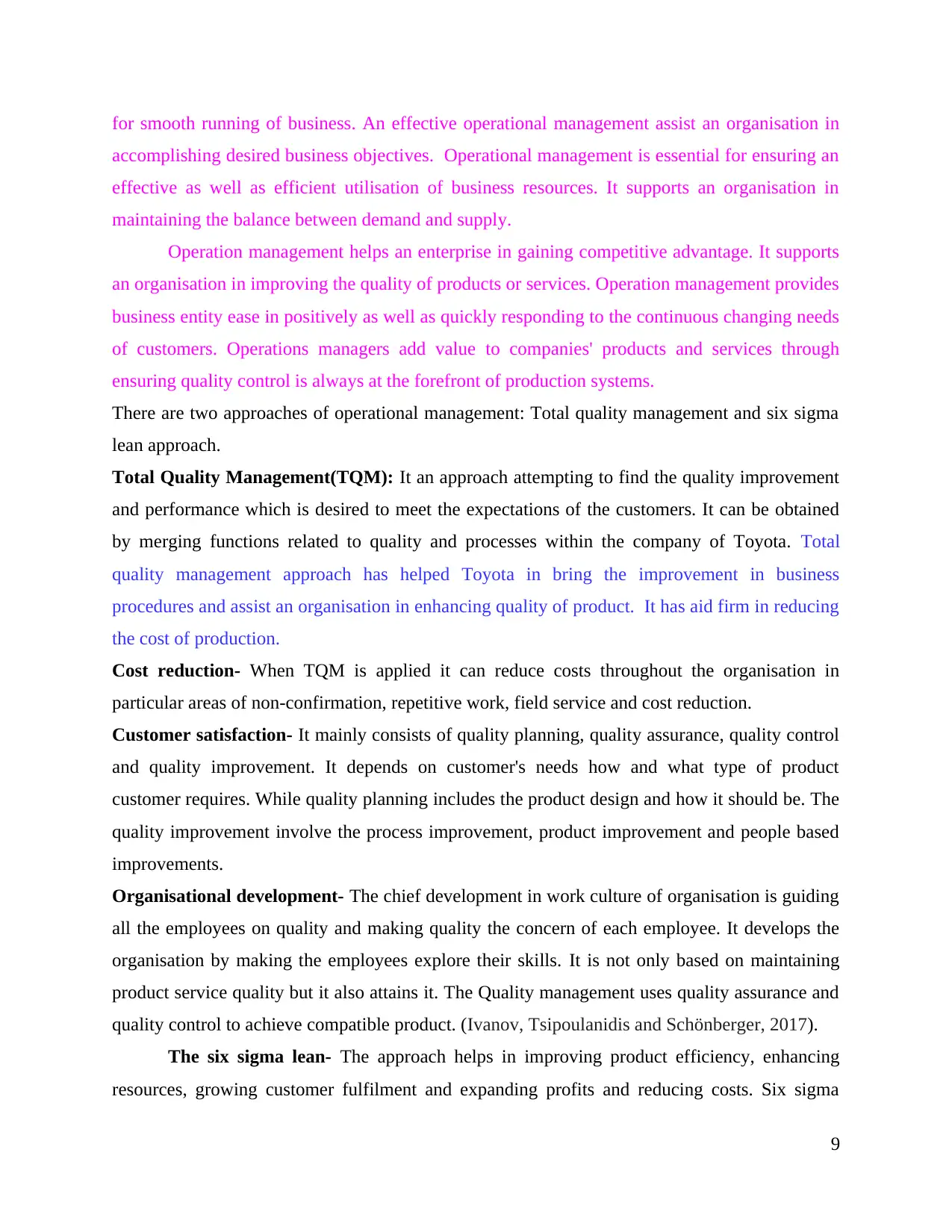
for smooth running of business. An effective operational management assist an organisation in
accomplishing desired business objectives. Operational management is essential for ensuring an
effective as well as efficient utilisation of business resources. It supports an organisation in
maintaining the balance between demand and supply.
Operation management helps an enterprise in gaining competitive advantage. It supports
an organisation in improving the quality of products or services. Operation management provides
business entity ease in positively as well as quickly responding to the continuous changing needs
of customers. Operations managers add value to companies' products and services through
ensuring quality control is always at the forefront of production systems.
There are two approaches of operational management: Total quality management and six sigma
lean approach.
Total Quality Management(TQM): It an approach attempting to find the quality improvement
and performance which is desired to meet the expectations of the customers. It can be obtained
by merging functions related to quality and processes within the company of Toyota. Total
quality management approach has helped Toyota in bring the improvement in business
procedures and assist an organisation in enhancing quality of product. It has aid firm in reducing
the cost of production.
Cost reduction- When TQM is applied it can reduce costs throughout the organisation in
particular areas of non-confirmation, repetitive work, field service and cost reduction.
Customer satisfaction- It mainly consists of quality planning, quality assurance, quality control
and quality improvement. It depends on customer's needs how and what type of product
customer requires. While quality planning includes the product design and how it should be. The
quality improvement involve the process improvement, product improvement and people based
improvements.
Organisational development- The chief development in work culture of organisation is guiding
all the employees on quality and making quality the concern of each employee. It develops the
organisation by making the employees explore their skills. It is not only based on maintaining
product service quality but it also attains it. The Quality management uses quality assurance and
quality control to achieve compatible product. (Ivanov, Tsipoulanidis and Schönberger, 2017).
The six sigma lean- The approach helps in improving product efficiency, enhancing
resources, growing customer fulfilment and expanding profits and reducing costs. Six sigma
9
accomplishing desired business objectives. Operational management is essential for ensuring an
effective as well as efficient utilisation of business resources. It supports an organisation in
maintaining the balance between demand and supply.
Operation management helps an enterprise in gaining competitive advantage. It supports
an organisation in improving the quality of products or services. Operation management provides
business entity ease in positively as well as quickly responding to the continuous changing needs
of customers. Operations managers add value to companies' products and services through
ensuring quality control is always at the forefront of production systems.
There are two approaches of operational management: Total quality management and six sigma
lean approach.
Total Quality Management(TQM): It an approach attempting to find the quality improvement
and performance which is desired to meet the expectations of the customers. It can be obtained
by merging functions related to quality and processes within the company of Toyota. Total
quality management approach has helped Toyota in bring the improvement in business
procedures and assist an organisation in enhancing quality of product. It has aid firm in reducing
the cost of production.
Cost reduction- When TQM is applied it can reduce costs throughout the organisation in
particular areas of non-confirmation, repetitive work, field service and cost reduction.
Customer satisfaction- It mainly consists of quality planning, quality assurance, quality control
and quality improvement. It depends on customer's needs how and what type of product
customer requires. While quality planning includes the product design and how it should be. The
quality improvement involve the process improvement, product improvement and people based
improvements.
Organisational development- The chief development in work culture of organisation is guiding
all the employees on quality and making quality the concern of each employee. It develops the
organisation by making the employees explore their skills. It is not only based on maintaining
product service quality but it also attains it. The Quality management uses quality assurance and
quality control to achieve compatible product. (Ivanov, Tsipoulanidis and Schönberger, 2017).
The six sigma lean- The approach helps in improving product efficiency, enhancing
resources, growing customer fulfilment and expanding profits and reducing costs. Six sigma
9
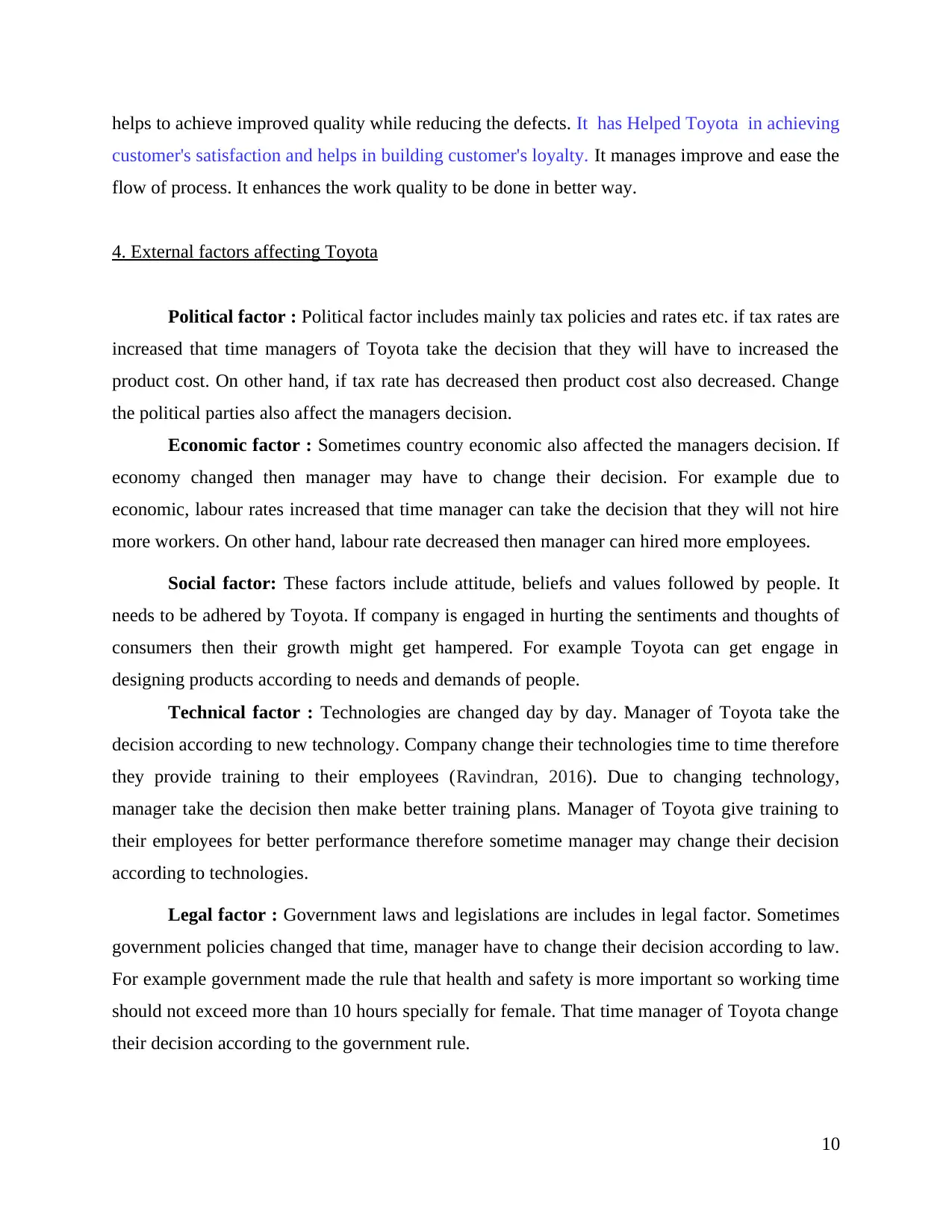
helps to achieve improved quality while reducing the defects. It has Helped Toyota in achieving
customer's satisfaction and helps in building customer's loyalty. It manages improve and ease the
flow of process. It enhances the work quality to be done in better way.
4. External factors affecting Toyota
Political factor : Political factor includes mainly tax policies and rates etc. if tax rates are
increased that time managers of Toyota take the decision that they will have to increased the
product cost. On other hand, if tax rate has decreased then product cost also decreased. Change
the political parties also affect the managers decision.
Economic factor : Sometimes country economic also affected the managers decision. If
economy changed then manager may have to change their decision. For example due to
economic, labour rates increased that time manager can take the decision that they will not hire
more workers. On other hand, labour rate decreased then manager can hired more employees.
Social factor: These factors include attitude, beliefs and values followed by people. It
needs to be adhered by Toyota. If company is engaged in hurting the sentiments and thoughts of
consumers then their growth might get hampered. For example Toyota can get engage in
designing products according to needs and demands of people.
Technical factor : Technologies are changed day by day. Manager of Toyota take the
decision according to new technology. Company change their technologies time to time therefore
they provide training to their employees (Ravindran, 2016). Due to changing technology,
manager take the decision then make better training plans. Manager of Toyota give training to
their employees for better performance therefore sometime manager may change their decision
according to technologies.
Legal factor : Government laws and legislations are includes in legal factor. Sometimes
government policies changed that time, manager have to change their decision according to law.
For example government made the rule that health and safety is more important so working time
should not exceed more than 10 hours specially for female. That time manager of Toyota change
their decision according to the government rule.
10
customer's satisfaction and helps in building customer's loyalty. It manages improve and ease the
flow of process. It enhances the work quality to be done in better way.
4. External factors affecting Toyota
Political factor : Political factor includes mainly tax policies and rates etc. if tax rates are
increased that time managers of Toyota take the decision that they will have to increased the
product cost. On other hand, if tax rate has decreased then product cost also decreased. Change
the political parties also affect the managers decision.
Economic factor : Sometimes country economic also affected the managers decision. If
economy changed then manager may have to change their decision. For example due to
economic, labour rates increased that time manager can take the decision that they will not hire
more workers. On other hand, labour rate decreased then manager can hired more employees.
Social factor: These factors include attitude, beliefs and values followed by people. It
needs to be adhered by Toyota. If company is engaged in hurting the sentiments and thoughts of
consumers then their growth might get hampered. For example Toyota can get engage in
designing products according to needs and demands of people.
Technical factor : Technologies are changed day by day. Manager of Toyota take the
decision according to new technology. Company change their technologies time to time therefore
they provide training to their employees (Ravindran, 2016). Due to changing technology,
manager take the decision then make better training plans. Manager of Toyota give training to
their employees for better performance therefore sometime manager may change their decision
according to technologies.
Legal factor : Government laws and legislations are includes in legal factor. Sometimes
government policies changed that time, manager have to change their decision according to law.
For example government made the rule that health and safety is more important so working time
should not exceed more than 10 hours specially for female. That time manager of Toyota change
their decision according to the government rule.
10
⊘ This is a preview!⊘
Do you want full access?
Subscribe today to unlock all pages.

Trusted by 1+ million students worldwide
1 out of 18
Related Documents
Your All-in-One AI-Powered Toolkit for Academic Success.
+13062052269
info@desklib.com
Available 24*7 on WhatsApp / Email
![[object Object]](/_next/static/media/star-bottom.7253800d.svg)
Unlock your academic potential
Copyright © 2020–2025 A2Z Services. All Rights Reserved. Developed and managed by ZUCOL.





